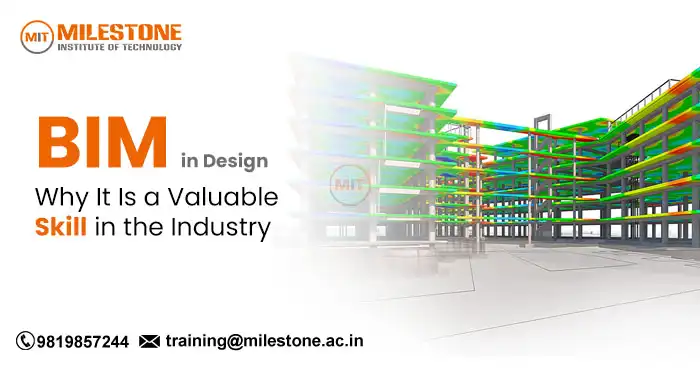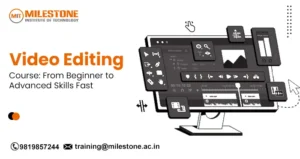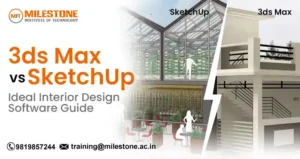
BIM in Design: Why It Is a Valuable Skill in the Industry
The design and construction field is experiencing a significant upheaval and one of the most significant factors propelling transformation is BIM in Design. Building Information Modeling, or BIM, has emerged as a credible tool that allows designers, architects and engineers to plan, visualize, and manage building projects more efficiently. Understanding BIM in Design, is now a major requirement of professionals wanting to differentiate themselves in a changing and highly competitive construction environment.What Is BIM in Design
BIM in the Design stage means having intelligent digital models that represent the physical and functional characteristics of a building. It is not a simple 3D model. It links all of the data (and design elements) into one environment for improved collaboration, increased accuracy, and improved project management. BIM in Design allows all of the project stakeholders to work on one shared model, which can promote consistency and efficiency throughout the project lifecycle.
Traditional design processes utilized drawings that referenced disconnected information. This made it very difficult to identify errors and timelines could become very costly. BIM in Design overcomes this by offering a central digital representation of the building that can be simultaneously updated and utilized in real time. This enables teams to visualize how all of the elements fit together, as well as what happens when design decisions affect another area of the project.
How BIM in Design Improves Collaboration
BIM in Design offers many benefits, with one of the most important being better collaboration among project professionals. In conventional methods, architects, engineers, and contractors would usually work independently, resulting in gaps in communication and misunderstandings. BIM in Design unites these professionals and brings them into a shared virtual space. Any changes made to a model by one team member is instantaneously communicated to all other team members so they can rely on and validate the same, accurate and up-to-date information.
This collaborative practice ultimately reduces errors and lessens the amount of rework needed to execute the project. It allows designers to explore numerous design alternatives, contemplate possible issues much earlier, and enhances the decision-making process. Improved communication and coordination through BIM in Design will develop more unified teams, and a higher quality project overall.
The Role of BIM in Design for Better Visualization
BIM in Design provides clients and stakeholders with accurate 3D visualizations of the whole project before construction begins, allowing them to see the final building’s appearance and functionality. This amount of clarity allows designers to make modifications into the design process rather than costly revisions during construction.
Visualization also gives the designer the ability to play with materials, lighting, and spatial relations. For instance, seeing how natural light will filter into a building or how a specific design choice may affect energy efficiency. This allows the design to be more sustainable and functional in support of the overall mission; phenomenal buildings. Thus, BIM in Design aids in the accuracy of design making to foster increased aesthetic performance and functional performance.
BIM in Design Enhances Accuracy and Reduces Errors
One of the biggest advantages of Building Information Modeling (BIM) in Design is accuracy. With all the data and drawings residing in a single model, the likelihood of discrepancies between separate drawings or documents is almost nonexistent. The system carries out clash detection or conflict detection between disparate pieces of information (e.g., electrical lines crossing through building structure). Detecting these conflicts early in the project saves time, and thus, reduces waste.
BIM in the Design also allows professionals to produce accurate quantity takeoffs, cost estimates, and schedules. The accuracy not only aids designers but also serves project managers and contractors. It allows for budget control, assignment of resources, and timely completion of the project.
The Growing Demand for BIM in Design Skills
The construction industry is quickly adopting digital technologies, and the global demand for professionals who have a deep understanding of BIM in Design is ever-growing. More and more architecture, engineering, and construction companies presently require proficiency in BIM as a minimum requirement for design roles. Governments and major infrastructure projects will also require the use of BIM to achieve standardization and transparency.
Professionals capable of understanding BIM in Design can work efficiently to manage projects that are highly complex with an element of efficiency, making them an invaluable asset to their employers. As a result, this skillset opens the door to career opportunities as BIM coordinators, BIM managers, design engineers, project planners, and others. By learning about BIM in design, professionals can foster positive career growth and remain relevant in a competitive arena.
BIM in Design Supports Sustainable Development
Sustainability is an important concern in today’s construction industry and BIM in Design is a key enabler of sustainability. It enables designers to leverage simulation tools and data analyses to assess the potential impact of their designs on the environment before construction starts. BIM in Design has been found to provide opportunities to optimize energy use, water consumption, and material selection and, in general, contributes to more ecological buildings and practices for environmental sustainability.
This capability is particularly necessary in urban environments where energy performance and sensitive use of resources is of high concern. As more emphasis is placed on sustainability and sustainable development throughout the world, the role of BIM in Design will continue to gain more prominence.
The Future of BIM in Design
The potential of BIM in Design moving forward holds thrilling prospects. With the advancement of technologies such as AI, VR, and digital twins, the power of BIM will be boosted even more. Designers of the future will not only be able to visualize buildings but also simulate real-world performance in different conditions. This will improve project management even further in the Vein of efficiency and predictiveness.
In the years to come, BIM in Design will be practiced as the world standard for all major construction and infrastructure projects. Professionals who are early adopters and learn this technology will be at par while others may follow.Conclusion
Design-based Building Information Modeling (BIM) is revolutionizing the construction industry. It promotes collaboration, enhances precision, decreases expenses, and advances sustainable design. For architects, engineers, and designers, being fluent in Design-based BIM has become a required competency, not an option. As technology continues to expand, individuals who possess Design-based BIM capabilities will be ready to use the industry into a framework that is increasingly efficient, creative, and ecologically responsible.Frequently Asked Questions
What is the role of a BIM designer?
- A BIM designer models 3D building models to improve coordination for design, and minimizing errors.
Which software is used in BIM?
- Common software includes Revit, Navisworks, SketchUp, ArchiCAD, Bentley Systems, etc.
Is BIM difficult to learn?
- It may be difficult to learn at first, with practice and training it will be easier.
What is the salary of BIM in India?
- A BIM designer salary is typically ₹4-8 LPA, depending on experience.



